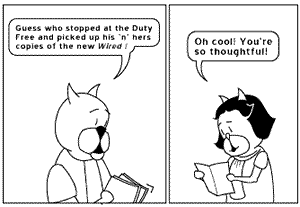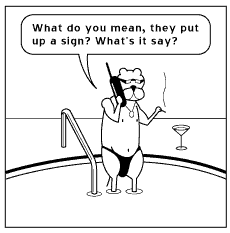A friend summed it up this way: "Achewood is just … weird," she said. She obviously liked it — maybe because it is weird, maybe because it’s also so familiar. If you grew up in middle America, you can’t help but feel a little conflicted about the strip.
Achewood by Chris Onstad is a bizarre middle-American satire. The storylines revolve around the characters’ interactions with popular culture and each other. Like the cast of The Simpsons, the characters are rooted in caricatures. But where Homer Simpson was a caricature of a particular socio-economic class and attitudes, Achewood‘s targets are broader personality traits and foibles. For example, Roast Beef’s sensitivity and vulnerability are at the center of stories that would make any sensitive geek cringe (and laugh) in recognition.
The ensemble cast are all different types to be foisted up for mockery. Philippe, the resident babe in the woods, is gullible and full of enthusiasm. So, of course, he’s constantly tricked or tortured. Roast Beef is the chronically depressed defeatist à la Charlie Brown. Ray is the overconfident troublemaker who thinks he’s much more suave than he is.
 Though they fit archetypal molds, the central cast are well developed and fully-realized enough to be able to step out of their boundaries, too. Ray has his compassionate moments, and they’re believable. Roast Beef has believable moments of joy, if only when he’s in heaven or living on the moon.
Though they fit archetypal molds, the central cast are well developed and fully-realized enough to be able to step out of their boundaries, too. Ray has his compassionate moments, and they’re believable. Roast Beef has believable moments of joy, if only when he’s in heaven or living on the moon.
Where another author might make Philippe simply cute and cloying relief from the strip’s cynicism, Onstad uses him for cruel laughs and gives Philippe a few dark thoughts of his own.
Some of the background characters are only one-note jokes — the Lie Bot, who tells nothing but cruel lies, is one example — but they’re handled as they should be. They’re foils for the main characters and they get no more attention than they need.
They move across a background of the bleakly mundane landmarks of suburbia: fast food places, hotel chains, and family restaurants. They eat at Subway and buy "balm" at 7-11.
The strip’s humor is often reminiscent of the cold mockery in The Onion, which will give a voice to the dregs of middle America with satiric intent. The joke is that these people and places, only slightly less dramatic, are familiar if you’ve lived in flyover country. You laugh because you know that guy.
If suburban blandness is the most common target of "edgy" comics, then broken taboos are a close second. On this front, too, Achewood takes the charge, and Onstad is willing to dial up the raunch to 11: putting a penis on the main dish at dinner, and taking the reader into the characters’ bathrooms and beyond.
The art in Achewood isn’t bad, but it’s obviously not the focus of the strip. The species of the animals in the comic are difficult to differentiate; the bears and the cats are both about the same size with similar pronounced jowls – neither especially look like real bears or cats or the typical cartoon shorthands for the animals. Characters of the same species are sometimes so similar that it is hard to individuate them on first reading. Onstad compensates by giving the characters signature accessories: glasses, hats, or, in one case, a thong.
 Early strips are also blank and open-feeling. They have a lot of white space. Recently, Onstad has started adding more background details and gray spaces to break up the panels, and it’s been a huge improvement. Compare this pool-side scene to this one to see the difference.
Early strips are also blank and open-feeling. They have a lot of white space. Recently, Onstad has started adding more background details and gray spaces to break up the panels, and it’s been a huge improvement. Compare this pool-side scene to this one to see the difference.
At heart, though, Achewood is about words. Onstad has an ear for language. You can hear it in the dialogue in Achewood, which sounds like a patchwork of assorted slang and common verbal shortcuts, a strip mall patois with a California tinge. (The word "hella" gives away the Cali influence. If Onstad were a New Englander, it would be "wicked" instead.) The humor is just as often in the way the characters talk as in what they say.
Strip storylines have allowed Onstad to showcase nearly note-perfect imitations of other writing styles, too, including the styles of Mark Twain, Hemingway, kid detective novels (on Achewood‘s Serializer space), and the stilted exchanges of early 20th century strips.
Onstad seems to be trying to make artistic strides with his work. His history of Achewood mentions that he’s submitted it to Fantagraphics, a publisher known for art comics, and he’s even taken out an ad in their journalism arm, The Comics Journal, which generally ignores comic strips when not savaging them as low, pop art. These overtures may reveal serious intentions. Is Onstad trying to make capital-A Art with Achewood? Webcomics are rarely that ambitious, but Achewood has the chops, if anyone does.
Onstad’s humor and tone are uncommon in comic strips, online and off. The strip has the distance of sharp satire. The characters are more defined by their personality flaws than their strengths, and it’s hard to imagine anyone identifying with them without a sense of irony. There’s an ironic distance between the reader and the characters in every panel, a fifth wall beyond the fourth.
At the same time, the popular culture references and some of the characters’ attitudes will strike a chord with anyone who’s lived in middle America. Achewood is stranger and darker than the suburban hinterlands, but it’s also very familiar. And that’s kind of weird.
This is a fantastically written review of Achewood. thank you for putting some of my thoughts into words.